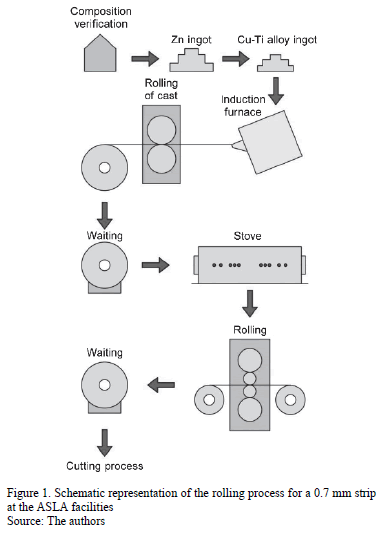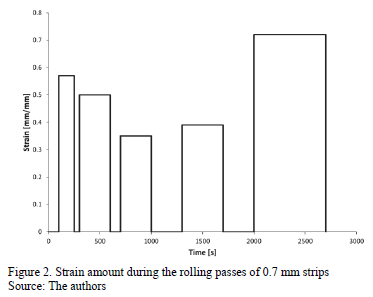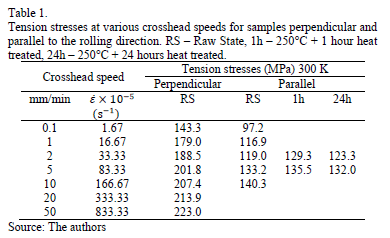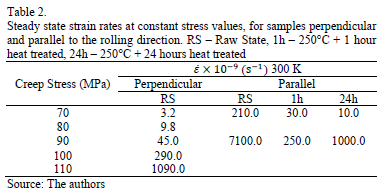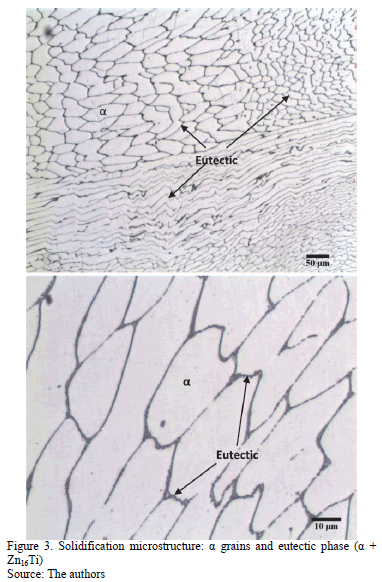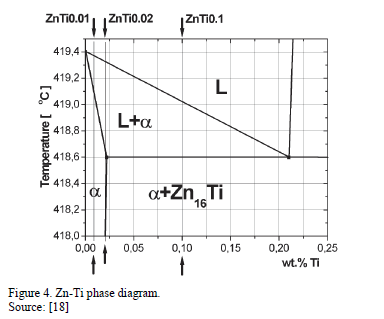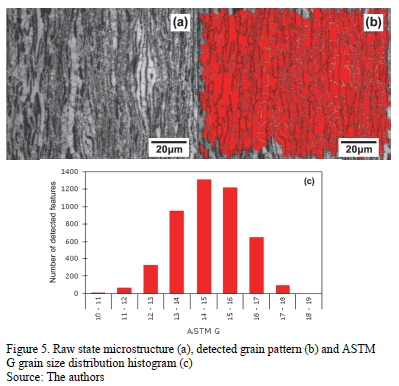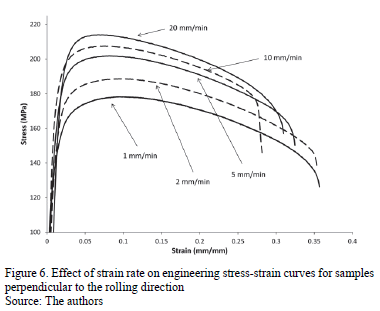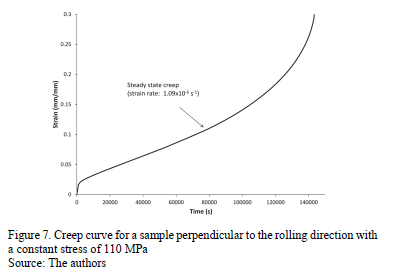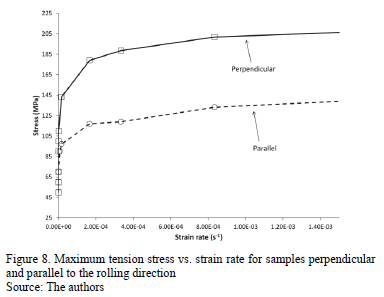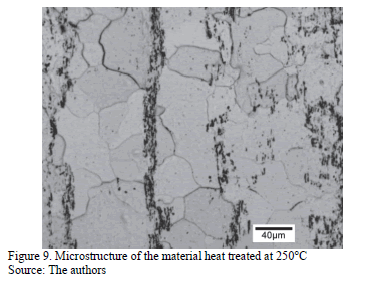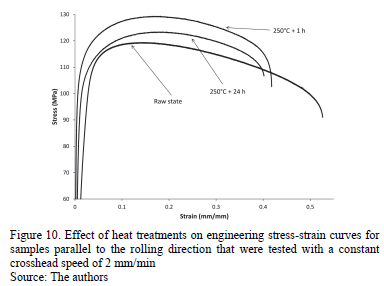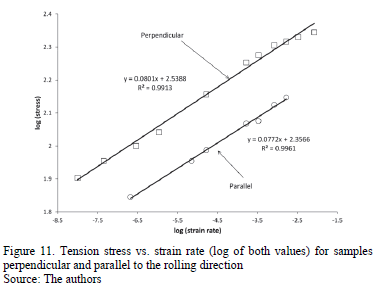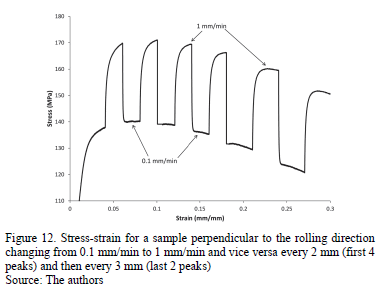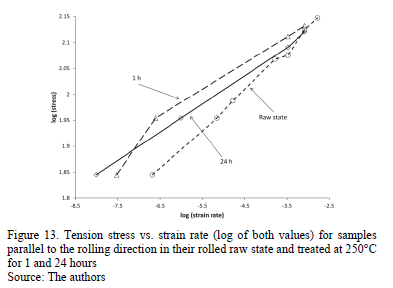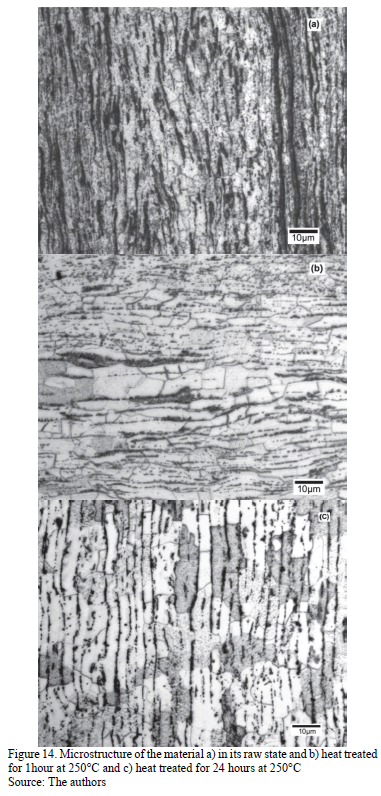Services on Demand
Journal
Article
Indicators
-
 Cited by SciELO
Cited by SciELO -
 Access statistics
Access statistics
Related links
-
 Cited by Google
Cited by Google -
 Similars in
SciELO
Similars in
SciELO -
 Similars in Google
Similars in Google
Share
DYNA
Print version ISSN 0012-7353
Dyna rev.fac.nac.minas vol.83 no.195 Medellín Jan./Feb. 2016
https://doi.org/10.15446/dyna.v83n195.44926
DOI: http://dx.doi.org/10.15446/dyna.v83n195.44926
Influence of strain rate and heat treatments on tensile and creep properties of Zn-0.15Cu-0.07Ti alloys
Influencia de la velocidad de deformación y tratamientos térmicos en las propiedades de tensión y fluencia del Zn-0.15Cu-0.07Ti
María José Quintana a, José Ovidio García b, Roberto González c & José Ignacio Verdeja d
a Facultad de Ingeniería, Universidad Panamericana, México, D.F., México. mquintana@up.edu.mx
b Escuela de Ingeniería de Minas, Energía y Materiales de Oviedo, Universidad de Oviedo, Oviedo, España. jovidio@uniovi.es
c Facultad de Ingeniería, Universidad Panamericana, México, D.F., México. robglez@up.edu.mx
d Escuela de Ingeniería de Minas, Energía y Materiales de Oviedo, Universidad de Oviedo, Oviedo, España. metalotecnia@etsimo.uniovi.es
Received: August 14th, 2014. Received in revised form: December 10th, 2015. Accepted: January 10th, 2016.
This work is licensed under a Creative Commons Attribution-NonCommercial-NoDerivatives 4.0 International License.

Abstract
The use of Cu and Ti in Zn alloys improves mechanical properties as solid solution and dispersoid particles (grain refiners) may harden the material and reduce creep deformation. This is one of the main design problems for parts made with Zn alloys, even at room temperature. In this work the mechanical behavior of a Zn-Cu-Ti low alloy is presented using tensile tests at different strain rates, as well as creep tests at different loads to obtain the value of the strain rate coefficient m in samples parallel and perpendicular to the rolling direction of the Zn strip. The microstructure of the alloy in its raw state, as well as heat treated at 250°C, is also analyzed, as the banded structure produced by rolling influences the strengthening mechanisms that can be achieved through the treatment parameters.
Keywords: Zn alloys; creep; strain rate coefficient; solid solution hardening; texture.
Resumen
El uso de Cu y Ti como aleantes del Zn mejora las propiedades mecánicas a través de solución sólida y partículas dispersas (promoviendo el afino de grano), resultando en materiales duros y resistentes al creep, lo que es, incluso a temperatura ambiente, uno de los principales problemas al diseñar piezas con aleaciones de Zn. El trabajo presenta el comportamiento mecánico de una aleación Zn-Cu-Ti a través de pruebas de tensión a diferentes velocidades de deformación, así como ensayos de fluencia a diferentes cargas para obtener el valor del coeficiente m de velocidad de deformación tanto en muestras paralelas a la dirección de laminación del material como en muestras perpendiculares. También se analizó la microestructura de la aleación en su estado de laminación, así como muestras tratadas a 250°C, ya que la estructura bandeada producto del rolado influye en los mecanismos de endurecimiento que se pueden alcanzar a través del tratamiento térmico.
Palabras clave: aleaciones de Zn; fluencia; coeficiente de velocidad de deformación; endurecimiento por solución sólida; textura.
1. Introduction
Zn alloys microalloyed with Cu and Ti are mainly used by the construction industry in roofing, gutters and drains [1]. The material is usually supplied as strips that, after solidification, have undergone hot rolling (between 250 and 100 °C). In some cases, room temperature rolling is also performed. Concepts of hot and cold rolling must be carefully considered because at 300 K (27 °C) Zn alloys have a temperature equivalent to 0.43 TM (the melting temperature is 649 K), which makes them behave like metals deformed at high temperatures (dynamic restoration, creep, static recrystallization after straining, etc.) [2].
A specific requirement for this material is its creep strength [3] when loaded at room temperature. For example, with stresses higher than 90 MPa, stationary strain rate must not reach or exceed  in both parallel and perpendicular directions compared to the rolling axis (in strips with thickness of 0.7 mm). Adding the microalloying elements Cu and Ti improves hot deformation strength by solid solution of Cu in Zn or by grain refining of the dispersoid Zn16Ti, which is formed during solidification [4-6]. The tensile and creep properties of this alloy are the product of hardening by grain refinement due to Zn16Ti [7-9], solid solution hardening by Cu in Zn [10-12] and also the increase in resistance in the direction perpendicular to the rolling axis caused by texture hardening [13-17].
in both parallel and perpendicular directions compared to the rolling axis (in strips with thickness of 0.7 mm). Adding the microalloying elements Cu and Ti improves hot deformation strength by solid solution of Cu in Zn or by grain refining of the dispersoid Zn16Ti, which is formed during solidification [4-6]. The tensile and creep properties of this alloy are the product of hardening by grain refinement due to Zn16Ti [7-9], solid solution hardening by Cu in Zn [10-12] and also the increase in resistance in the direction perpendicular to the rolling axis caused by texture hardening [13-17].
The material analyzed in this work was manufactured by "Asturiana de Laminados (ASLA)" in facilities located at Asturias, Spain, using continuous casting equipment of the "Twin roll casting" type, which produces 8 mm thick slabs in the form of coils (Fig. 1).
After a 10-hour homogenization treatment at 250°C, hot rolling is undertaken in a reversible "Steckel" train at temperatures between 250 and 100°C in 5 phases. A final thickness of 0.7 mm is obtained (Fig. 2).
As the industrial application of parts manufactured with Zn alloys is conditioned by room temperature creep, this work analyzes the behavior of a Zn - Cu - Ti alloy that has been deformed at room temperature in tensile tests (different strain rates) or applied with a constant load (creep tests) in both the raw state and heat treated conditions. The anisotropy of the rolled strip is also considered.
2. Experimental procedure
The strip produced by ASLA that is 0.7 mm thick is a Zn-0.15% Cu- 0.07% Ti used in industrial applications. Samples for mechanical testing were obtained from the Zn strip in both parallel and perpendicular directions relative to the rolling axis and were then machined as tension test samples with a calibrated gage length of  = 100 mm (ASTM E8-04). The samples were tested using an Instron 5583 standard universal machine, while varying crosshead speeds (Table 1) until total fracture of the specimens. Also, creep tests were performed in samples with the same geometries by applying a constant load until steady strain rate behavior was observed for a considerable period of time (Table 2).
= 100 mm (ASTM E8-04). The samples were tested using an Instron 5583 standard universal machine, while varying crosshead speeds (Table 1) until total fracture of the specimens. Also, creep tests were performed in samples with the same geometries by applying a constant load until steady strain rate behavior was observed for a considerable period of time (Table 2).
Furthermore, tension tests changing the crosshead speed (from 0.1 mm/min to 1 mm/min) every 2 or 3 mm were undertaken in order to calculate the strain rate equation coefficient. To compare the behavior of the raw state rolled material with that of the samples modified by heat treatments, tension test specimens were heat treated at 250°C for periods of 1 and 24 hours.
Microstructural characterization of the samples was undertaken using a metallographic cutter to observe longitudinal sections of the thin slab casting as well as the parallel direction of the thin strip. Traditional grinding and polishing techniques were used to obtain a mirror finish, as well as etching using Palmerton reactive. Metallographic characterization was performed through optical microscopy with Nikon Epiphot equipment and the quantitative analysis of the grain sizes of the a-Zn grains was undertaken using a Buehler Omnimet image analyzer connected to the optic microscope. This allowed for automatic grain identification and ASTM grain size measurement to be used, although in the case of the heat treated samples manual counting techniques were employed.
3. Results
The microstructure of the thin slab casting is shown in Fig. 3. Columnar grains of a-Zn (disperse constituent) are surrounded by an eutectic matrix (a+Zn16Ti), just as is expected from the phase diagram (Fig. 4) [18]:

The phase diagram indicates a 74% presence of proeutectic phase and 26% of eutectic, which results in approximately 1.1% of Zn16Ti. It is, therefore, an abundant dispersoid capable of grain refinement and a barrier to the restoration and recrystallization processes during hot deformation.
Moreover, the microstructure of the raw hot rolled state strips (0.7 mm in thickness) observed in a section parallel to the rolling direction (Fig. 5a) is that of a restored material, partially recrystallized, and with bands in the rolling direction. Just as Kurz [19] observes, lighter zones are a-Zn grains and darker ones are a+Zn16Ti eutectics which were not separated nor spheroidized after the homogenization and hot deformation treatments. The optical microscopy does not show Zn16Ti, neither at the boundaries nor at the interior of the a-Zn grains. Also, the size of the a-Zn grains where the eutectic is deformed is smaller than at the bands where the eutectic is not present. The quantitative measurements (Fig.s 5b-c) indicate a very small grain size with a mean length of a-Zn, close to 2 µm (14.5 ASTM).
In order to evaluate the response of this material to strain rate, tensile tests were made at different crosshead speeds in samples both parallel and perpendicular to the rolling direction, as indicated by Table 1. As expected, the higher the strain rate the higher maximum stress the material may withstand, as shown in the engineering stress-strain curves for perpendicular samples (Fig. 6). Though the sample tested at 10 mm/min may have fractured due to defects produced during machining, the rest of the samples have a tendency to deform by larger amounts (values as high as 37%) when low strain rates are used.
On the other hand, samples parallel to the rolling direction present lower maximum stresses (Table 1), although deformations between 50 and 55% are reached in all samples. This confirms the effect of the banded structure and crystallographic texture in the anisotropic mechanical behavior.
As the resistance of the material under constant load is very important in Zn alloys, creep tests were performed in order to determine the strain rate (steady state creep) [16,20,21] for the material (Table 2). Although samples with stresses above 90MPa were tested until they completely deformed and fractured, showing the typical creep curve [22] of strain vs. time (Fig. 7), lower stress levels showed very low strain values. These tests were only carried out until the steady state strain rate was evident.
If the values of stress (maximum stress for tensile tests and constant stress for creep) vs. strain rate are plotted for all the samples tested, it becomes evident that parallel and perpendicular samples have a similar profile: as strain rate is higher, stress reaches a plateau of approximately 190 MPa for the perpendicular samples and 125 MPa for the parallel ones (Fig. 8).
Furthermore, in order to analyze the possibility of improving creep behavior of parallel samples through the modification of microstructural features [23], heat treatments at 250°C were undertaken for periods of 1 and 24 hours. Fig. 9 shows evident microstructural changes due to the activation of diffusional processes [17]: the strip has recrystallized, grain size has grown (13 µm or 9 ASTM for 1 h and 15 µm or 8.5 ASTM for 24 h) and is more homogeneous, and the eutectic phase has fragmented which results in bands diminishing. Nevertheless, Zn16Ti are still not observed at either boundaries or at the interior of a-Zn grains.
If tensile tests are compared in the case of samples parallel to the rolling direction (Fig. 10), the one hour treatment seems to increase mechanical properties (also indicated in Table 1) caused by the disappearance of the continuous eutectic bands. The 24 hour treatment can only slightly improve mechanical resistance (or even decrease it) depending on the strain rate (Fig. 9 and Table 1): grain growth and Zn16Ti coarsening during recrystallization softens the material [3] and the disappearance of continuous bands results in a continuous a-Zn deforming phase.
4. Discussion
If the data for maximum stress (in the case of tensile tests) or constant stress (in the case of creep tests) is plotted vs. strain rate (strain rate of the tensile tests or steady state creep rate of the creep tests), using logarithm of both variables, a linear behavior is observed in the parallel and perpendicular directions (Fig. 11), especially above 90 MPa.
In order to confirm that the value of the  coefficient (
coefficient ( ) is actually the one indicated by the data in Fig. 11 (slopes), a tensile test varying strain rate every 2 or 3 mm from 0.1 to 1 mm/min (Fig. 12) was undertaken. Consider the following equation:
) is actually the one indicated by the data in Fig. 11 (slopes), a tensile test varying strain rate every 2 or 3 mm from 0.1 to 1 mm/min (Fig. 12) was undertaken. Consider the following equation:

where the  ratio in this test is 10,
ratio in this test is 10,  is the peak value of each step at the 1 mm/min curve sections and
is the peak value of each step at the 1 mm/min curve sections and  is the last value of the 0.1 mm/min curve section before the crosshead speed changes. The
is the last value of the 0.1 mm/min curve section before the crosshead speed changes. The  coefficient was calculated: for the samples in the parallel direction
coefficient was calculated: for the samples in the parallel direction  , while for the perpendicular direction
, while for the perpendicular direction  . Both values are very similar to the ones observed in Fig. 11, and much lower (0.13~0.33) than the ones reported by Reed-Hill [24].
. Both values are very similar to the ones observed in Fig. 11, and much lower (0.13~0.33) than the ones reported by Reed-Hill [24].
In Fig. 13 Stress vs. Strain rate of samples heat treated for 1 and 24 hours at 250°C and the data of the material in its raw state is presented. Although at low strain rates the heat treated samples show higher strength and higher creep resistance than the raw state material, at high strain rates the values converge. This may be an indication that plastic mechanisms activated at low strain rates are different to the ones at high strain rates: at 300 K, creep in these type of alloys is characterized by intergranular sliding, thus the increase in grain size by the 250°C treatments will slow the effect of this mechanism [9].
A comparison of microstructures in a raw state and after both heat treatments (250°C) for 1 and 24 hours is presented in Fig. 14. The increase in resistance for the one hour sample may be explained by the appearance of small, more homogeneously distributed dispersoids (precipitation hardening); however the 24 hour sample no longer presents the fine precipitates. Instead, there are coarser ones (overaging), which explains the decrease in mechanical properties. Furthermore, evidence of twinning is observed in the heat treated samples, which also explains the higher mechanical properties compared to the raw state ones [25-28].
5. Conclusions
Although the mechanical resistance of this alloy in the direction perpendicular to the rolling axis is higher than the parallel one, the strain rate coefficient  in both directions is very similar (0.07~0.08). Moreover, heat treatments at 250°C may increase mechanical properties (tensile and creep resistance), especially at low strain rates. Deformation mechanisms at high strain rates are very similar for raw state and heat treated samples.
in both directions is very similar (0.07~0.08). Moreover, heat treatments at 250°C may increase mechanical properties (tensile and creep resistance), especially at low strain rates. Deformation mechanisms at high strain rates are very similar for raw state and heat treated samples.
The strengthening of heat treated samples deformed at low strain rates may be explained by the combination of the disappearance of continuous bands, twinning of the a-Zn grains and the appearance of homogeneously distributed precipitates.
Acknowledgments
The authors wish to thank the technical staff at the Asturiana de Laminados - ASLA (www.elzinc.es) for providing the material used for this research and detailed information of the rolling process for the Zn-Cu-Ti alloys.
References
[1] Barnhurst, R.J., Zinc and Zinc alloys, in Metals Handbook Vol. 2, 10th ed., USA, ASM, 1990. pp. 527-542. [ Links ]
[2] Jonas, J.J. and Mc-Queen, H.J., Recovery and recrystallization during high temperature deformation, in Mise en Forme des Métaux et Alliages, Paris, Editions de CNRS, 1976, pp. 99-143. [ Links ]
[3] Matsunaga, T., Kameyama, T., Takahashi, K. and Sato, E., Constitutive relation for ambient-temperature creep in hexagonal close-packed metals. Materials Transactions, 50(12), pp. 2858-2864, 2009. DOI: 10.2320/matertrans.M2009223 [ Links ]
[4] Valadez, S., Zanatta, A., Robles, S. and Valdez, S., Microstructural analysis of Al-Mg-Si-Zn Alloy. DYNA, 77(163), pp. 9-12, 2010. [ Links ]
[5] Boczkal, G., Second phase morphology in the Zn-Ti0.1-Cu0.1 single crystals obtained at different growth rates. Archives of Metallurgy and Materials, 57(2), pp. 479-484, 2012. [ Links ]
[6] Faur M. and Cosmeleata G., Effects of hot and cold rolling on the microstructure of low alloy Zn-Cu and Zn-Cu-Ti zinc alloy with improved corrosion resistance. U.P.B Scientific Bulletin Series B, 68(1), pp. 67-74, 2006. [ Links ]
[7] Jaoul, B., Etude de la plasticité et application aux metaux. Paris: Dunod, 1965, pp. 362-400, 481-511. [ Links ]
[8] Das, S.K., Kang, D.H. and Jung, I.H., Experimental and diffusion simulation for the homogenization of As-cast Mg-Al, Mg-Zn and Mg-Al-Zn alloys. Metallurgical and Materials Transactions A, 45A(11), pp. 5212-5225, 2014. DOI: 10.1007/s11661-014-2443-6 [ Links ]
[9] Xiao, L.R., Zhang, X.M., Wang, Y., Li, W., Sun, Q.S. and Geng, Z.J., High temperature creep behavior of Zn-1.0Cu-0.2Ti Alloy. Advanced Materials Research, 287-290(7), pp. 769-776, 2011. DOI: 10.4028/www.scientific.net/AMR.287-290.769 [ Links ]
[10] Hirth, J.P. and Lothe, J., Theory of dislocations. New York: Wiley, 1968. pp. 637-753. [ Links ]
[11] Dieter, G.E., Mechanical metallurgy. UK: McGraw-Hill, 1988. pp. 185-240. [ Links ]
[12] Pero-Sanz, J.A., Ciencia e Ingeniería de Materiales. Madrid: Cie Dossat, 5th ed., 2006. pp. 393-446. [ Links ]
[13] Cosse P., D'Heeyer, R., Coutsouradis, D. et Habrajen, L., Le comportement à l'emboutissage du Zinc et d'alliages de Zinc. Mémoires Scientifiques Revue de Métallurgie, pp. 517-528, 1978. [ Links ]
[14] Penelle, R., Influence de l'anisotropie sur la limite d'élasticité et la loi de comportement, in Mise en Forme des Métaux et Alliages, Paris, Editions de CNRS, 1976, pp. 75-85. [ Links ]
[15] Barrett, C.S., Structure des Métaux. Paris: Dunod, 1957, pp. 417-478. [ Links ]
[16] Deka, D., Joseph, D., Ghosh, S. and Mills, M., Crystal plasticity modeling of deformation and creep in polycrystalline Ti-6242. Metallurgical and Materials Transactions A, 37A(5), pp. 1371-1388, 2006. DOI: 10.1007/s11661-006-0082-2 [ Links ]
[17] Doiphode, R.L., Narayana Murty, S.V.S., Prabhu, N. and Kashyap, B.P., High-temperature tensile flow behavior of caliber-rolled Mg-3Al-1Zn Alloy, Metallurgical and Materials Transactions A, 46A(7), pp. 3028-3042, 2015. DOI: 10.1007/s11661-015-2883-7 [ Links ]
[18] Mikulowski, B. and Boczkal, G., Zn-Ti single crystals deformed along the basal slip system. Archives of Metallurgy and Materials, 54(1), pp. 197-203, 2009. [ Links ]
[19] Kurz, W. and Trivedi, R., Banded solidification microstructures. Metallurgical and Materials Transactions A, 27A(3), pp. 625-634, 1996. DOI: 10.1007/BF02648951 [ Links ]
[20] Blum, W., Eisenlohr, P. and Breutinger, F., Understanding Creep - A review. Metallurgical and Materials Transactions A, 33A(2), pp. 291-303, 2002. DOI: 10.1007/s11661-002-0090-9 [ Links ]
[21] Peschanskaya, N.N., Shpeizman, V.V., Sinani, A.B. and Smirnov, B.I., Micrometer-Scale deformation jumps at different stages of creep in solids. Physics of the Solid State, 45(11), pp. 2058-2062, 2004. DOI: 10.1134/1.1825549 [ Links ]
[22] Winter, R., EZAC - High strength, creep resistant, Zinc die casting alloy. Die Casting Engineer, (3), pp. 32-35, 2011. [ Links ]
[23] Mahmoud, S.A., Semary, M.A., Farid, Z.M. and El-Naquib, N., On two types of creep behaviour of Cu-Zn solid solution. Materials Science and Engineering A, 118(10), pp. 107-111, 1989. DOI: 10.1016/0921-5093(89)90062-2 [ Links ]
[24] Reed-Hill, R.E., Physical metallurgy principles. Second Edition, University Series in Basic Engineering, 1994, pp. 827-887. [ Links ]
[25] Zhu, Y.T., Liao, X.Z., Wu, X.L., Narayan, J., Grain size effect on deformation twinning and detwinning. Jounal of Materials Science, 48, pp. 4467-4475, 2013. DOI: 10.1007/s10853-013-7140-0 [ Links ]
[26] Jenei, P., Gubicza, J., Dirras, G., Lábár, J.L. and Tingaud, D., Indentation creep study on ultrafine-grained Zn processed by powder metallurgy. Materials Science & Engineering A. 596, pp. 170-175, 2014. DOI:10.1016/j.msea.2013.12.050 [ Links ]
[27] Boczkal, G., Mikulowski, B., Oertel, C.G. and Skrotzki, W., Work-hardening characteristics of Zn-Ti alloy single crystals. Crystal Research and Technology, 45(2), pp. 111-114, 2010. DOI: 10.1002/crat.200900537 [ Links ]
[28] García-Bernal, M.A., Hernandez-Silva, D. and Sauce-Rangel, V., Superplastic behavior of coarse-grained Al-Mg-Zn alloys. Journal of Material Science, 42, pp. 3958-3963, 2007. DOI: 10.1007/s10853-006-0368-1 [ Links ]
M.J. Quintana, received her BSc. Eng in Mechatronics Engineering in 2006, her Sp. degree in Advanced Manufacturing Systems in 2007, her MSc. degree in Engineering in 2010, all of them from the Universidad Panamericana, Mexico City, Mexico. She was awarded her PhD in Science and Technology of Materials in 2013 from the Universidad de Oviedo. Oviedo, Spain. She has worked since 2007 in the Faculty of Engineering at the Universidad Panamericana, first as an invited professor, and since 2011 as an associate professor and researcher. Her research interests include: finite element simulation, material testing and characterization, selection of materials for engineering applications. ORCID: 0000-0002-1926-9910
J.O. García, received his Adv. Technician degree in 1975, from the Polytechnic School of Oviedo, Spain. Has worked in the Universidad de Oviedo since 1982 as a lab teacher in the Materials Department, and now also works as an associate professor on the Science and Engineering course. His research interests include: optical and electronical microscopy, mechanical testing, thermal treatments and alumino-thermal welding. ORCID: 0000-0002-9156-7349
R. González, received his BSc. Eng in Mechanical and Electrical Engineering in 1991 from the Universidad Panamericana, Mexico City, Mexico and his PhD in Mechanical Properties and Structure of Materials in 1996 from CEIT - Universidad de Navarra, San Sebastián, Spain. Since 1996 he has worked in the Faculty of Engineering at the Universidad Panamericana as associate professor and researcher and is currently Dean of the Mechatronics and Mechanic Engineering programs. His research interests include: finite element simulation, material testing and characterization, tribology, design theory. ORCID: 0000-0003-2319-1631
J.I. Verdeja, received his Mining Eng. degree from the Adv. Tech. School of Mining Eng. in Madrid in 1968, his Nuclear Eng. degree from the Nuclear Energy Board in 1969, his PhD in Mining from the Adv. Tech. School of Mining Eng. of Oviedo in 1974, and a PhD form the University of Paris in 1978. He began to work in the Adv. Tech. School of Mining Eng. of Oviedo in 1974 as an invited and associate professor and then as an associate chairman in 1983. His research interests include: steels, castings and metallic alloys in general. ORCID: 0000-0002-4446-6457













